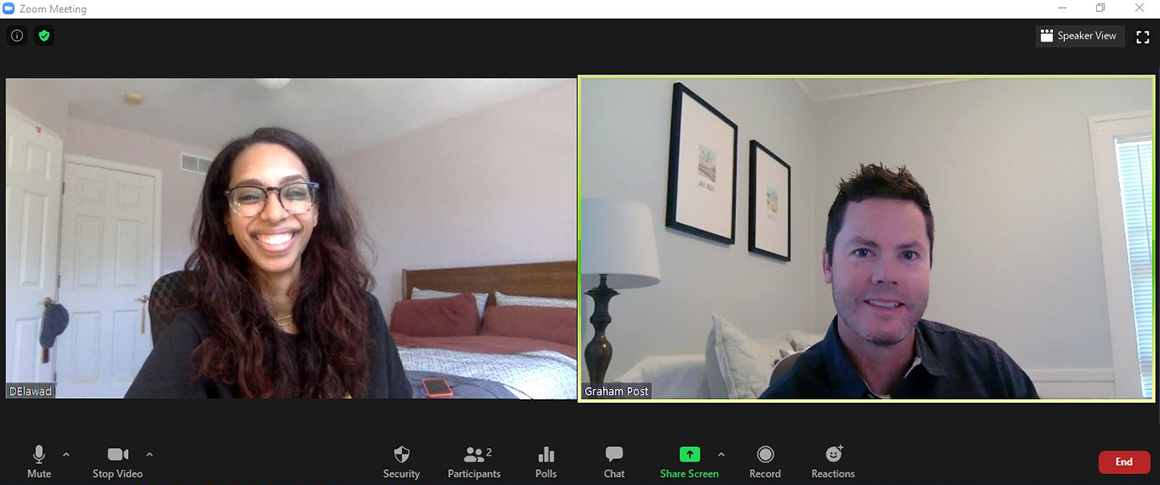The opinions expressed in this commentary are solely those of the author and do not necessarily reflect those of the National Council of Architectural Registration Boards (NCARB).
The coronavirus pandemic has forced architecture firms to embrace remote work. While some companies have begun to slowly reopen their offices based on statewide regulations, other firms are allowing staff to continue to work from home for an extended period of time, and some even permanently. The architecture profession must be resilient in the face of adversity that comes with the downturns of isolated work, and effectively mentoring licensure candidates remotely is a key component to success.
As we navigate these uncertain times, we must ensure that important items, such as training and mentorship, maintain a prominent place in professional development toolkits. By building relationships and mentoring junior members through virtual technology, architecture firms will continue developing employees, while including them on the team. Architecture firms have the unique opportunity to create an effective remote mentoring program by becoming proactively connected with the junior employees. This includes scheduling time for availability, challenging mentees, and assisting in growing their network.
“Meet” Regularly
Communication is key and starts from the top, encouraging senior leaders to engage with mentees and initiate conversation. Simply begin by reaching out individually to unlicensed staff to see how this work-from-home experience is impacting them, especially pertaining to their career growth. Here are a few initial questions that have helped me frame these conversations:
- Architect Registration Examination® (ARE®): Amid the closure of Prometric test centers, and now their limited capacity, how have you adjusted your testing plan? Do you have additional time to focus on your studies?
- Architectural Experience Program® (AXP®): Compared to when we were in the office, do you feel that you are getting more or less mentoring through your day-to-day or project-to-project? What AXP areas do you still need to gain experience in?
- Mentorship: If you do feel a decrease in a mentorship connection with senior architects, how can I help close that gap?
Virtual Reviews
When the stay-at-home orders went into effect throughout the country in early-March, many firms were approaching quarterly or mid-year reviews. Some have had to cancel or hit pause on these reviews, and now so much time has gone by without the forums for feedback. To move forward and maintain a sense of normalcy, some organizations have conducted reviews virtually. I’ve learned that even in an informal setting, these opportunities for constructive feedback can prove invaluable for both parties, which is so important during these times of isolation.
Onboard New Team Members
Establishing a confident foothold for communication and collaboration is essential. With construction halting and projects going on hold around the country, many firms have experienced changes in personnel over the last few months. This can require junior staff to begin working on new teams, which can sometimes be from other office locations. New teams, new people, and a fast pace can lead to obstacles for consistent professional nurturing. So it’s important to recognize opportunities for good communication with new team members beyond the day-to-day tasks.
I highly encourage leveraging video capability to engage beyond the less personal phone call. Look toward structuring a tempo for project related check-ins that make sense for both parties, as well as the project cadence. Encouraging candidates to ask questions will help form a healthy relationship and allow for more constructive feedback.
Confirm Understanding
For team leaders who may be taking on a new workload and teammates, they may feel submerged in a state of treading water just to keep things moving and may rush through things unintentionally. We’ve all had those times where we return to our desk, and halfway through the first task we get stuck and don’t want to bug the person again. Let’s work to recognize these situations and have the ability to take the time to ensure comprehension is received and everyone is on the same page.
Encourage Self-Sufficiency
Project managers and staff should collectively understand overall project workflow, milestones, and deliverables. This promotes an entrepreneurial spirit among candidates staff, allowing them to look beyond the daily tasks. Challenge them to develop their problem-solving skills and take the initiative in proactively figuring something out on their own.
Foster Community
Remember that mentoring should not be reserved for only AXP supervisors. Together, discuss the structure of current mentorship and develop a network to fulfill multiple points of interest. Establishing a base network will allow mentees to have a place to seek out answers to questions that may not be fulfilled by the immediate project team, as well as keep career goals in perspective.
Candidates may want to organize virtual hangouts, happy hours, or conference calls among their peers. It’s important for them to be able to interact and have a voice without the shadow of the boss. These interactions also allow them to stay connected and share their individual licensure progress while working apart.
Look Ahead
Seeking opportunities for greater exposure to a variety of work-related tasks will help promote growth, as well as new responsibilities. One of my mentors once said, “train your own replacement.” At first glance, this concept may hint at hesitation for fear of job security, but by adequately training your employees, your ability to advance and take on new responsibilities increases and elevates your own role.
Working remotely will continue to trend across the architecture, engineering, and construction (AEC) industry. For longevity, it is important for firms and companies to actively provide creative mentorship opportunities and promote the growth of the next generation of architects.
Graham Post, NCARB, is a Senior Architect at Nelson Worldwide who strives to create exceptional environments for his clients, designing spaces that are inspired while meeting the clients’ needs and vision. He collaborates directly with clients and oversees projects from the earliest design phases through construction. His design sense coupled with technical expertise helps bridge the gap between concept and execution.
